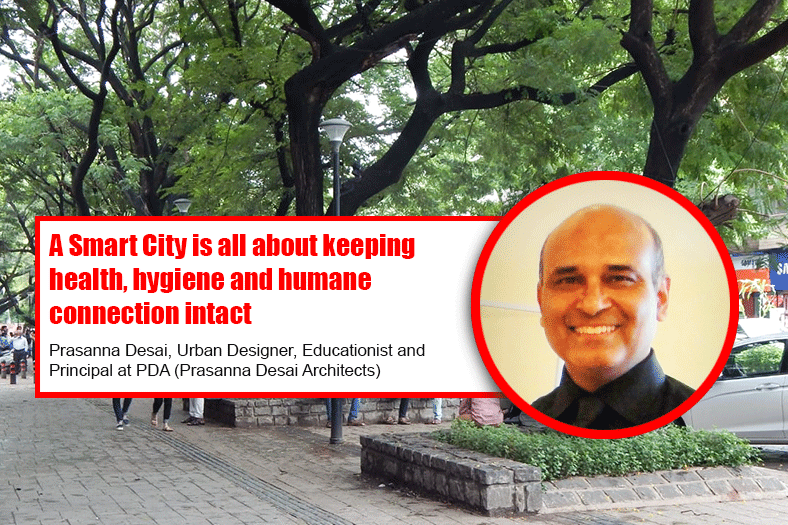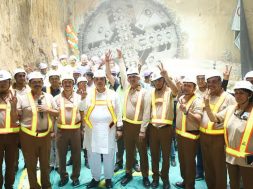Indian cities were smart to begin with

Prasanna Desai, Urban Designer, Educationist and Principal at PDA (Prasanna Desai Architects) on what makes cities smarter and the projects his firm had been involved with as a part of the smart city initiative.
What in your own words is a smart city? What is the role of architecture and urban design in smart cities?
In simple words, it is about creating healthy, hygienic and habitable neighbourhood, which will lead to a smart city. And this will also lead to quantitative, economic and environmental changes. To bring this change; the role of architects, urban designers, landscape architects, planners, economists, sociologists, engineers, bureaucrats, politicians and above all citizens will be mighty crucial. For any initiative to succeed there should be a bottom up approach and if citizens are part of this then it will reach the right conclusion.
When the initiative of 100 smart cities were announced, there was an impression that 100 new cities will come into existence. 100 new cities dominated with high-rises like the existing metro cities. This thought process in itself is a fallacy. It is important to understand that Indian cities were smart to begin with. It took into account all the factors involved like sustainability, functionality, climate etc. Cities like Jodhpur, Jaisalmer some good examples to cite.
A smart city has to provide a vibrant eco-system,maintaining work life balance is equally important. All the old cities in India had one simple way to address this issue “neeche dukan, upar makaan”. This helped in reducing the distance between your work place and home to a bare minimum, today this concept is called as mixed land use. Our cities with mixed land use are our strength and we should upgrade and retrofit them. The term smart should not always be understood as a high-tech city, we just have to keep health, hygiene and humane connection going.
How does a smart city enhance the life of its citizens?
To begin with, you will have access clean air. In a smart city people will be actively encouraged to engage in carpooling, utilize public transport, and abhor using vehicles for short distances. The urban planning and design will be such that people will have to abide by such rules. This will ensure that the quality of air will not deteriorate. It will also reduce congestion which is a major issues across all cities.Then the provision for open spaces and vegetation is also very important. Other three factors which will enrich the lives of its citizens include walkability, cycling and bus based transport.
What about the rail road connectivity?
It depends upon the size of the smart city in question. For example for a city like the size of Mumbai, railways will prove to be effective. Chennai too has a similar system. The metro too can be a valuable addition but only if it is made underground. A completely underground metro will lead to cost escalation but it will be well worth is in the long run. The metro has to have last mile connectivity with either buses, feeder buses and then the most important in this cycle are the auto rickshaws and walkability.
It has been five years since the smart city initiative what have we have now done different that we did not do earlier?
Well initiatives have been undertaken to improve the urban and rural infrastructure earlier too, the have been executed from time to time irrespective of the political outfit in power. Earlier, it was JNNURM (Jawaharlal Nehru National Urban Renewal Mission), then there was Slum Rehabilitation Project under BSUP (Basic Services for the Urban Poor) scheme. The schemes and plans have been there in the past but what smart cities concept has done it has brought cities into limelight and the whole country is talking about it. That credit goes to smart city initiative. At the end of the day, smart cities are not about technology alone, it depends upon the will of the people and hence people need to be aware of it.
What are some of the projects you have executed under the mission so far?
Under the Smart City Mission and there is a programme called CITIIS (City Investments to Innovate Integrate and Sustain) and I am a mentor for this programme. CITIIS is the main component of the ‘Supporting Smart Cities Mission for a more Inclusive and Sustainable Urban Development in India’ launched by the Ministry of Housing and Urban Affairs in 2018. CITIIS is currently involved in 15 different projects across the country under the initiative and I am associated with two.
One of our projects involves upgrading 25 villages in the Amaravati district of Andhra Pradesh. We are upgrading the quality of the health centers, anganwadis, primary and secondary schools.Likewise we are also involved in a project based in Visakhapatnam for upgradation of 150 municipal schools.
Cities in itself are complex structures and hence the Smart City mission has adopted a Bottom-up approach. Bottom-up approach of urban planning’ generally means that local governments or committees formed by local citizens are responsible for urban planning of their own districts, solving the urban problems and planning their future development, and thus the districts link together to make the whole nation or region become more developed.
We are also have an initiative called Healthy Aundh, it consists of redesigning existing streets in the Aundh neighbourhood. The new street design will support walkability, cycling, universal accessibility, and requisite amount of tree cover. The project is under progress.
Cookie Consent
We use cookies to personalize your experience. By continuing to visit this website you agree to our Terms & Conditions, Privacy Policy and Cookie Policy.









